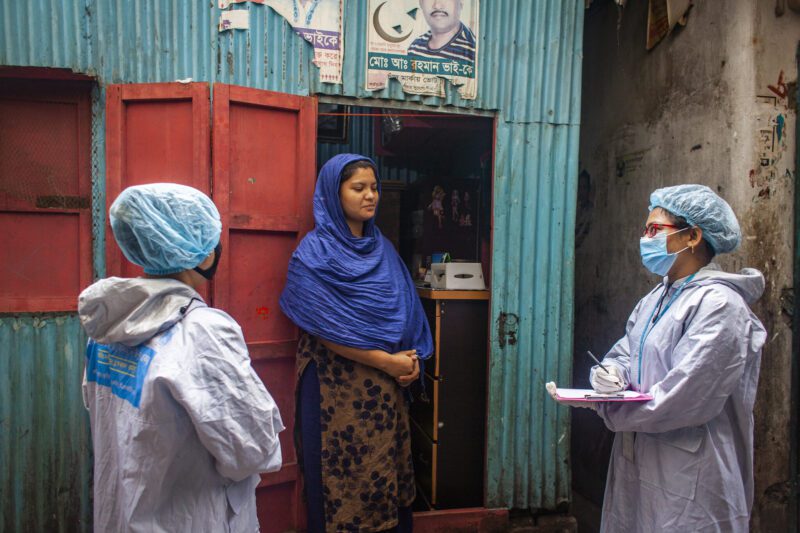By Ida Jooste, Internews Senior Health Advisor
Today marks exactly three years since the WHO declared COVID-19 a Public Health Emergency of International Concern. Immediately, vaccine strategies were top of mind for the health science community, and a vaccine was created at impressive speed. However, even before the first dose was produced, wealthy countries worked to seize vaccine supply as it became available. Production and distribution could not match global demand. For a long time, a world where whoever wants a COVID vaccine can get one seemed like a far-fetched dream.
Today, that world is a reality. Vaccine supply exceeds demand in most places. And yet, we still haven’t reached the desired numbers of vaccinated people. Exceptionally low vaccination rates prevail in low-income countries and among certain constituencies in wealthier countries. Vaccine hesitancy has crippled our best chance at putting the pandemic behind us.
Much has been written about this hesitancy’s primary cause – a massive wall of misinformation that undermined confidence in the vaccines and the public health officials administering them. The WHO Director-General said it best: “We are not just fighting an epidemic; we are fighting an infodemic.”
My job is to analyze the dynamics behind the infodemic, come up with solutions, and work with media outlets around the world to implement them. As Senior Health Advisor, this is not the first time that me and my team have fought a global infodemic. During the Ebola Outbreak in West Africa in 2014 – 2016, we helped media groups in Liberia and Guinea disseminate reliable information and empower communities to be agents in their own survival and recovery. We did the same during successive Ebola outbreaks in the Democratic Republic of the Congo and Uganda. Lessons from the Ebola response and our ongoing HIV work with media have prepared us to handle the most vulnerable contexts during COVID-19.
It is time we learn from both past and present pandemics, so we can be prepared for the next one – and save millions of lives. There are three main lessons that governments, media actors, and health professionals can draw:
First, we must invest in the capacity of media to counter misinformation. Public health investments that rely simply on “supply” – health infrastructure and vaccines – are bound to fail if they are not paired with investments that increase popular demand. Equipping journalists to deliver high-quality information about health issues and effectively counter misinformation is critical to upping demand.
Take the example – early in the pandemic – of alternative methods being touted to cure COVID. Whether it’s inhaling steam or taking hydroxychloroquine, rumors about alternative remedies can take root in large swaths of the population and make the vaccine feel unnecessary. Ongoing beliefs that “COVID is not real” or “is a mild disease” have the same effect. With adequate training and resources, the media can provide access to reliable information that ensures people make well-informed decisions that are best for their own health. Realizing that the COVID-19 vaccine would dominate news (from anticipation, to creation, to rollout and demand – or lack of it) we set out to create a resource which would guide journalists through this multi-faceted story. Let’s Talk Vaccines, is a comprehensive online course which helps journalists translate the language of vaccine science and the promise of vaccine access into compelling human stories. So far, over 2000 journalists have taken the Let’s Talk Vaccines course, in English.
Second, we need to identify and engage “info ambassadors” who enjoy the trust of a community. In contexts where there is deep mistrust between citizens and institutions, official sources often fail to influence common behaviors and practices; in fact, their attempts can backfire. This is a space where “unofficial” or informal but credible sources can thrive: artists, community leaders, social media personalities, religious leaders, and trusted media outlets.
Starting from a place of empathy and curiosity, they can acknowledge and validate the questions of the community and be a trusted place to find answers. It’s essential to ensure that any effort to counter misinformation and spread dependable information about the vaccine – or any health-related issue – makes allies of widely recognized and trusted actors. The evidence of the success of this approach is abundant – from youth ambassadors in The Philippines combating COVID-19 misinformation to Congolese radio stations responding to the Ebola outbreak.
Third, there should be far stronger collaboration between public health officials and journalists. Collaboration does not mean agreement, of course. In all our media training and the through the media science cafes we support, we emphasize that journalists, scientists, public health officials, and health advocates need to all be connected to one another for a health story to see the light. They all have distinct roles that needs to be respected. It is the media’s job to ask tough questions and hold officials accountable. When those officials own this accountability and are available to the media, and when researchers are willing and equipped to make their science accessible, it serves them better overall. They are better trusted, and people are better served.
It is often said that crises reveal people’s true character. The same principle can be applied to entire societies. The COVID-19 pandemic has exposed the fatal consequences of misinformation and fake news – but, if we draw the right lessons from it, it can bolster humanity’s plans for future pandemic preparedness. When the next global health emergency hits, the rollout of healthcare measures will need to be accompanied by a robust plan to tackle misinformation – and support for the media outlets that do this work every day.
Viral misinformation has cost us lives. Trusted information can save them.
